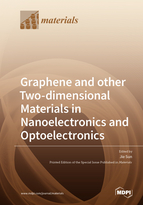Graphene and other Two-dimensional Materials in Nanoelectronics and Optoelectronics
A special issue of Materials (ISSN 1996-1944).
Deadline for manuscript submissions: closed (15 November 2019) | Viewed by 26903
Special Issue Editor
Interests: semiconductor materials/devices, especially GaN micro-LED displays and other devices based on GaAs and InP; 2D materials/devices, especially MOCVD growth and integration with III-Vs
Special Issue Information
Dear Colleagues,
Graphene and other two-dimensional (2D) materials have been one of the hottest research areas in the past decade. Giant projects, e.g., the EU Graphene Flagship led by Chalmers, have been launched. Today, commercial graphene products are readily available. However, most of them are graphene-based powders, paints, and composites. They are exciting, but one should not forget that the original motivation of Geim et al. to explore graphene was to study its field effect, hoping it would play a key role in post-silicon electronics. After all, nanoelectronics and optoelectronics are the main thread for 2D materials. That is the field where scientists tell the public 2D materials could replace, or at least complement the dominant role of Si in electronics.
Graphene’s carrier mobility is one of the highest among all materials, making it promising in high speed electronics. The lack of bandgap makes the transistor on–off ratio, as well as current saturation, hard to improve. However, MoS2, phosphorene, etc., possess large enough bandgaps. 2D insulators, such as h-BN, are also available. Therefore, the combination of 2D semiconductors, conductors and insulators is very valuable in post-silicon electronics. In addition, 2D materials are promising in optoelectronics, both for active elements, such as light emitting substances, and for passive elements, such as transparent electrodes. Generally speaking, the advantages of using 2D materials in nanoelectronics and optoelectronics include their ultra-small thickness, mechanical flexibility, sustainability, large varieties of material combinations, and most importantly, their outstanding optical and electrical properties. One thing worth mentioning is that, taking graphene as an example, it is not hard to find materials competing well with graphene in terms of mobility, electrical and thermal conductivity, transmittance, flexibility, etc.; nevertheless, it seems impossible to find something that combines all these properties in one single material—I believe that this is the fascinating part of graphene.
It is my pleasure to invite you to submit manuscripts to this Special Issue. Full papers, communications and reviews on experimental and theoretical studies of atomically-thin 2D materials in nanoelectronics and optoelectronics are all welcome.
Prof. Jie Sun
Guest Editor
Manuscript Submission Information
Manuscripts should be submitted online at www.mdpi.com by registering and logging in to this website. Once you are registered, click here to go to the submission form. Manuscripts can be submitted until the deadline. All submissions that pass pre-check are peer-reviewed. Accepted papers will be published continuously in the journal (as soon as accepted) and will be listed together on the special issue website. Research articles, review articles as well as short communications are invited. For planned papers, a title and short abstract (about 100 words) can be sent to the Editorial Office for announcement on this website.
Submitted manuscripts should not have been published previously, nor be under consideration for publication elsewhere (except conference proceedings papers). All manuscripts are thoroughly refereed through a single-blind peer-review process. A guide for authors and other relevant information for submission of manuscripts is available on the Instructions for Authors page. Materials is an international peer-reviewed open access semimonthly journal published by MDPI.
Please visit the Instructions for Authors page before submitting a manuscript. The Article Processing Charge (APC) for publication in this open access journal is 2600 CHF (Swiss Francs). Submitted papers should be well formatted and use good English. Authors may use MDPI's English editing service prior to publication or during author revisions.
Keywords
- Graphene
- 2D materials
- semiconductors
- nanoelectronics
- optoelectronics







